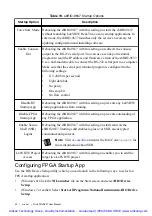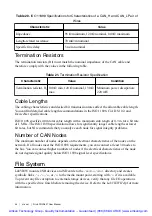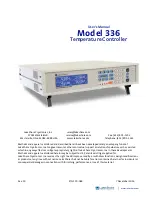
for that range. Refer to the
NI sbRIO-9637 Specifications
on
ni.com/manuals
for the
maximum working voltage for each range.
If any of these conditions are exceeded, the input voltage is clamped until the fault condition is
removed.
Best Practices for Scanning Multiple Channels
NI sbRIO devices can scan multiple channels at high rates and digitize the signals accurately.
If your application scans multiple channels, settling error can affect the accuracy of your
measurements. Settling error is a difference between the input value and the value that the
ADC digitizes, and is the result of switching between multiplexed input channels. NI defines
settling error as the difference between a single-channel measurement of a signal and a
multiple-channel measurement of the same signal. Settling errors are directly proportional to
channel-to-channel voltage step size and the time between acquisitions. NI sbRIO devices scan
at a fixed rate equal to the maximum aggregate rate.
To ensure the lowest possible settling errors, design your application according to the
following best practices:
•
Use low-impedance sources—Ensure that the impedance of signal sources is less than
1 kΩ. High-impedance sources increase settling errors and decrease accuracy at fast
scanning rates. You can reduce impedance by connecting a voltage-follower circuit
between the signal source and the AI pin of the channel. For more information about
reducing impedance, visit
ni.com/info
and entering the Info Code
rdbbis
.
•
Use short, high-quality cabling—Using short, high-quality cables can minimize several
effects that degrade accuracy, including crosstalk, transmission line effects, and noise.
The capacitance of the cable can also increase the settling error. NI recommends using
individually shielded twisted-pair wires shorter than 2 m to connect AI signals to the
device. Refer to the
Connecting Analog Input Signals
section for more information.
•
Minimize voltage step between adjacent channels—Settling error increases with the
voltage step between channels. If you know the expected input ranges of your signals,
you can group signals with similar expected ranges together on adjacent channels.
Note
When you program your I/O node with a scan list, the NI sbRIO device scans
channels in numerical order at a fixed rate. Calling a second I/O node adds an extra
delay before the first channel but does not reduce settling error.
Differential Measurement Configurations
To attain more accurate measurements and less noise on the sbRIO-9637, use a differential
measurement configuration. A differential measurement configuration requires two inputs for
each measurement, reducing the number of available channels from 16 to eight. The following
table shows the signal pairs that are valid for differential connection configurations.
Table 16. Differential Analog Input Signals
Channel
Signal -
0
AI0
AI8
1
AI1
AI9
NI sbRIO-9637 User Manual
|
© National Instruments
|
31
Artisan Technology Group - Quality Instrumentation ... Guaranteed | (888) 88-SOURCE | www.artisantg.com
















































